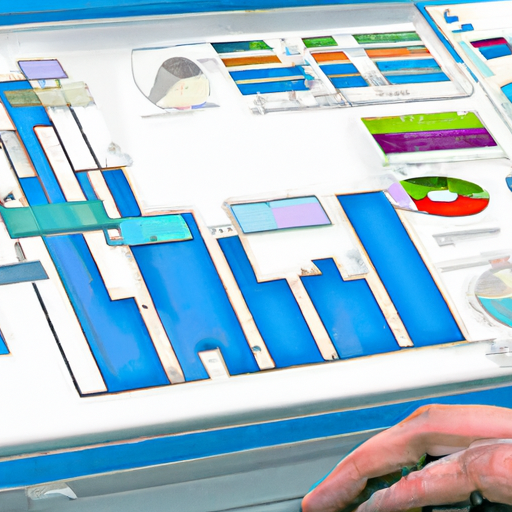What Technological Trends Affect The Food Truck Industry?
In today’s rapidly changing digital landscape, the food truck industry is not immune to the influence of technological trends. From mobile ordering apps to advanced POS systems, technology has transformed the way food trucks operate and connect with their customers. In this article, we will explore some of the key technological trends that are shaping the future of the food truck industry, helping vendors stay competitive and providing customers with a seamless dining experience on wheels.

Table of Contents
Online Ordering Systems
Benefits of online ordering systems for food trucks
Online ordering systems offer numerous benefits for food truck businesses. Firstly, they provide convenience for customers by allowing them to place their orders from the comfort of their own homes or offices. This not only saves them time and effort but also attracts a wider customer base, as people who may not have been able to visit the food truck in person can now enjoy its offerings.
Furthermore, online ordering systems streamline the ordering process for food trucks. They eliminate the need for customers to wait in long queues, enabling them to place their orders quickly and effortlessly. This increases customer satisfaction and reduces the risk of lost sales due to long waiting times.
Online ordering systems also facilitate efficient order management for food trucks. They provide a centralized platform where all incoming orders can be easily tracked, managed, and processed. This helps food truck owners and staff stay organized, reduce errors, and ensure timely order fulfillment.
Popular online ordering platforms for food trucks
There are several popular online ordering platforms available for food trucks to choose from. One such platform is ChowNow, which offers a user-friendly interface and customizable options for food truck owners. Another popular choice is Toast, which provides seamless integration with point-of-sale (POS) systems, making it easier to manage orders and payments.
Other notable online ordering platforms for food trucks include Square Online, Grubhub, and Uber Eats. Each platform offers unique features and benefits, so food truck businesses should carefully assess their specific needs and select the best platform that aligns with their objectives.
Integration with payment gateways and mobile wallets
Integration with payment gateways and mobile wallets is an essential aspect of online ordering systems for food trucks. This feature allows customers to make secure and convenient payments directly through the online platform. By offering multiple payment options, such as credit cards, debit cards, and mobile payment apps, food trucks can cater to a wider range of customer preferences.
Integration with payment gateways also simplifies the accounting process for food truck businesses. It automatically updates and records all transactions, making it easier to track revenue, reconcile accounts, and generate financial reports.
Furthermore, integration with mobile wallets, such as Apple Pay and Google Pay, enhances the overall customer experience. Many customers prefer to use these digital wallets for their convenience and security, and by integrating with them, food trucks can offer a seamless and modern payment experience.
Mobile Apps for Food Trucks
Advantages of having a mobile app for a food truck
Having a mobile app can provide several advantages to food truck businesses. Firstly, a mobile app serves as a direct and personalized communication channel with customers. Through push notifications and in-app messaging, food trucks can easily inform their customers about their menu updates, special offers, and upcoming locations. This allows for better customer engagement and increases the likelihood of repeat business.
Moreover, a mobile app can enhance the overall customer experience by providing features such as loyalty programs and order history. Loyalty programs can incentivize repeat purchases and build customer loyalty, while an order history feature allows customers to easily reorder their favorite items, saving them time and effort.
Another advantage of having a mobile app is the ability to collect valuable customer data. By tracking customer preferences and order patterns, food truck businesses can gain insights into their target market and tailor their offerings accordingly. This data can also be used for targeted marketing campaigns and personalized promotions, further boosting customer engagement and satisfaction.
Features to consider in a food truck mobile app
When developing a mobile app for a food truck business, there are several key features to consider. Firstly, an intuitive and user-friendly interface is essential. The app should be easy to navigate, with clear and visually appealing menus and options.
Integration with online ordering and payment systems is also crucial. This allows customers to place their orders directly through the app and make secure payments. Additionally, GPS integration can provide real-time updates on the food truck’s location, ensuring that customers can easily track its whereabouts and plan their visit accordingly.
Incorporating social media sharing features can also be beneficial, as it allows customers to share their positive experiences and recommendations with their friends and followers. This word-of-mouth promotion can significantly contribute to the growth of a food truck business.
Lastly, a mobile app should have an analytics dashboard that provides insights into customer behavior and app usage. This data can help food truck businesses make informed decisions regarding menu updates, pricing strategies, and marketing campaigns.
Digital Marketing and Social Media
The impact of social media on food truck businesses
Social media has had a significant impact on the success of food truck businesses. Platforms such as Facebook, Instagram, and Twitter provide food trucks with a cost-effective and easily accessible marketing channel. By showcasing their offerings, engaging with customers, and promoting special events or locations, food trucks can create a strong online presence and attract a dedicated following.
Moreover, social media allows for direct and interactive communication with customers. Food trucks can respond to customer inquiries, address concerns, and gather feedback in real-time. This level of engagement builds trust and loyalty among customers, ultimately leading to increased sales and customer satisfaction.
Social media also enables food trucks to leverage user-generated content. When customers share photos and positive reviews of their food truck experience, it serves as free advertisement and social proof, attracting new customers and boosting the credibility of the business.
Utilizing digital marketing strategies for food trucks
In addition to social media, food trucks can utilize various digital marketing strategies to expand their reach and increase their customer base. Search Engine Optimization (SEO) techniques can help improve the visibility of a food truck’s website or online ordering platform in search engine results. By optimizing keywords, meta tags, and website structure, food trucks can attract organic traffic and outrank their competitors.
Content marketing is another effective strategy for food trucks. By creating and sharing valuable and relevant content, such as recipes, cooking tips, or behind-the-scenes videos, food trucks can position themselves as industry experts and build trust with potential customers. This can be done through blog posts, videos, podcasts, or social media posts.
Email marketing campaigns can also be utilized to engage with customers and promote special offers or events. By collecting customer email addresses through online ordering platforms or in-person interactions, food trucks can send personalized emails with targeted promotions and updates. This keeps the food truck top of mind and encourages repeat business.
Building a strong online presence
Building a strong online presence is crucial for the success of food truck businesses. It involves creating a consistent and cohesive brand image across all digital channels. This includes having a visually appealing website or online ordering platform that reflects the personality and offerings of the food truck.
Consistent branding should also extend to social media profiles and content. The food truck’s logo, colors, and tone of voice should be present across all platforms to create a recognizable and memorable brand identity. Additionally, engaging with followers, responding to comments and messages, and regularly posting high-quality content helps maintain an active and engaged online presence.
Collaborating with influencers or partnering with local businesses and events can also help boost the visibility and reach of a food truck. By leveraging their existing audience and networks, food trucks can tap into new customer segments and gain exposure to a wider audience.
Contactless Payments
The rise of contactless payments in the food truck industry
Contactless payments have become increasingly prevalent in the food truck industry, driven by advancements in technology and changing consumer preferences. With the rise of mobile payment apps, such as Apple Pay and Google Pay, customers now expect the convenience and security of contactless payments.
The COVID-19 pandemic also accelerated the adoption of contactless payments in the food truck industry. Many customers became more conscious of hygiene and preferred to use touchless payment methods to minimize physical contact.
Furthermore, contactless payments offer benefits for both food truck businesses and customers. They speed up transaction times, as customers can simply tap their cards or phones to complete the payment process. This reduces queue times and increases customer satisfaction. From a business perspective, contactless payments can also improve cash flow and reduce the risk of theft or counterfeit money.
Benefits of accepting contactless payments
Accepting contactless payments provides several benefits for food truck businesses. One of the main advantages is enhanced customer experience. By offering the convenience of contactless payments, food trucks can provide a frictionless and efficient purchasing process, which aligns with modern consumer expectations.
Contactless payments also improve operational efficiency for food trucks. They eliminate the need for cash handling, reducing the risk of errors and saving time during busy periods. Additionally, contactless payments can be integrated with inventory management systems, making it easier to track sales and maintain accurate stock levels.
From a security standpoint, contactless payments are more secure than traditional card payments. With encryption and tokenization technologies, customer payment data is protected and less vulnerable to fraud or data breaches. This helps build trust with customers and protects the reputation of the food truck business.
Types of contactless payment methods
Several contactless payment methods are available for food trucks to consider implementing. The most widespread method is contactless card payments, which utilize Near Field Communication (NFC) technology. Customers can simply tap their contactless-enabled credit or debit cards on a card reader to make a payment.
Mobile payment apps, such as Apple Pay, Google Pay, and Samsung Pay, are also popular contactless payment options. These apps allow customers to store their credit or debit card information on their smartphones and make payments by holding their phones near a card reader or tapping them on a contactless payment terminal.
QR code-based payments are another option for food trucks. Customers can scan a QR code displayed on a food truck signage or menu using their smartphones and make a payment through a designated payment app. This method is widely used in markets where smartphone penetration is high, such as China.
Lastly, wearable devices, such as smartwatches or fitness trackers, offer contactless payment capabilities. Customers can link their payment cards to their wearable devices and make payments by holding the device near a contactless payment terminal. This provides a convenient and stylish payment option for tech-savvy customers.
Internet of Things (IoT) in Food Trucks
How IoT technology can enhance operations in food trucks
The Internet of Things (IoT) technology has the potential to revolutionize operations in food trucks. By connecting various devices and sensors through the internet, food trucks can automate and optimize their processes, leading to increased efficiency and cost savings.
One application of IoT technology in food trucks is remote monitoring and control of appliances and equipment. By installing IoT-enabled sensors, food truck owners can remotely monitor factors such as temperature, humidity, and energy usage. This allows for proactive maintenance and prevents equipment failures, minimizing downtime and reducing repair costs.
IoT technology also enables real-time tracking of inventory levels. By tagging items with IoT sensors, food trucks can monitor their stock levels in real-time and receive alerts when inventory reaches a predetermined threshold. This ensures that food trucks can efficiently manage their supplies, reduce waste, and avoid stockouts.
Furthermore, IoT devices can enhance food safety in food trucks. Temperature sensors can monitor the storage and transportation of perishable items, ensuring that they are kept at the appropriate temperatures to prevent spoilage. This helps food trucks comply with food safety regulations and maintain the quality of their products.
IoT applications for inventory management and food safety
IoT technology offers several applications for inventory management and food safety in food trucks. As mentioned earlier, IoT sensors can be used to monitor inventory levels in real-time and provide automatic alerts when stock is running low. This enables food truck owners to streamline their procurement process, ensuring that they always have sufficient supplies on hand.
Additionally, IoT sensors can help track the movement of inventory within the food truck. By tagging each item with a sensor, food trucks can monitor the movement of products throughout their supply chain, from storage to preparation to final delivery. This increases transparency and reduces the risk of theft or misplaced items.
IoT technology also plays a crucial role in maintaining food safety standards. Temperature sensors can monitor the cold chain during the transportation and storage of perishable items. If the temperature deviates from the desired range, an alert can be sent to the food truck owner or staff, allowing them to take immediate corrective action. This helps ensure that food is stored and transported at the appropriate temperatures, minimizing the risk of foodborne illnesses.
IoT-enabled devices for food truck businesses
Several IoT-enabled devices are available for food truck businesses to enhance their operations. One such device is a smart thermostat, which can be installed in refrigerators or freezers to monitor and regulate the temperature. These thermostats often have built-in Wi-Fi connectivity, allowing for remote monitoring and control.
Connected scales are another IoT-enabled device that can benefit food truck businesses. These scales can automatically measure and track the weight of ingredients, making it easier to manage inventory and ensure accurate recipe preparation. They can be integrated with inventory management systems to provide real-time updates on ingredient usage.
IoT-enabled food safety devices, such as temperature probes or data loggers, are critical for maintaining food safety standards in food trucks. These devices can continuously monitor the temperature of food items and provide detailed logs or alerts if any fluctuations occur. This enables food truck owners to take immediate action to rectify any issues and ensure the safety of their products.
Connected vehicles and GPS trackers are also important IoT-enabled devices for food trucks. They provide real-time location tracking, allowing food truck owners to optimize route planning, monitor driver behavior, and ensure timely deliveries. This enhances operational efficiency and customer satisfaction.
Food Truck Management Software
Benefits of using management software for food trucks
Food truck management software offers several benefits for food truck businesses. Firstly, it simplifies the overall management and operations of a food truck, allowing owners and staff to focus on delivering high-quality food and customer service.
With management software, food truck owners can streamline various aspects of their business, such as inventory management, menu planning, and employee scheduling. By centralizing these tasks in a single platform, owners can save time, improve efficiency, and reduce the risk of errors.
Management software also provides valuable insights and analytics that can help food truck owners make data-driven decisions. By analyzing sales data, customer preferences, and operational metrics, owners can identify areas for improvement, optimize their menu offerings, and implement targeted marketing strategies.
Furthermore, management software typically integrates with other systems, such as online ordering platforms, payment gateways, and accounting software. This seamless integration eliminates the need for manual data entry and reduces the risk of data discrepancies, ensuring accurate and up-to-date information across all systems.
Features to look for in food truck management software
When selecting food truck management software, there are certain key features to consider. Firstly, inventory management capabilities are essential. The software should allow for easy tracking of ingredient usage, stock levels, and expiration dates. It should also provide alerts or automatic reordering options when inventory reaches a predetermined threshold.
Integration with online ordering platforms and payment gateways is another crucial feature. This allows for centralized order management and streamlined payment processing. It also eliminates the need for manual data entry and reduces the risk of errors or delays in order fulfillment.
Employee scheduling and labor management features are also important for food truck businesses. The software should provide tools for creating and managing employee schedules, tracking hours worked, and calculating payroll. This helps ensure compliance with labor laws and optimizes staffing levels based on customer demand.
Additionally, reporting and analytics capabilities are valuable for food truck owners. The software should generate detailed reports on sales, customer behavior, and operational metrics. These reports can help owners identify trends, measure performance, and make informed decisions to drive business growth.
Popular software options for food truck businesses
There are several popular software options available for food truck businesses. One widely used option is Square for Restaurants, which provides comprehensive features for food order management, table mapping, in-depth analytics, and payment processing. Square’s intuitive interface and affordable pricing make it a popular choice for food trucks of all sizes.
Another popular software is SpotOn Restaurant, which offers a range of tools for online ordering, loyalty programs, and marketing campaigns. SpotOn’s integration with popular third-party apps, such as Grubhub and Uber Eats, makes it a convenient option for food trucks that utilize multiple online ordering platforms.
Other notable software options for food truck businesses include Toast POS, Lightspeed POS, and TouchBistro. Each software has its own unique features and pricing plans, so food truck owners should carefully assess their specific needs and budget before selecting the most suitable option.
GPS Tracking and Fleet Management
Using GPS tracking to optimize route planning and scheduling
GPS tracking is a valuable tool for food trucks as it allows for optimized route planning and scheduling. By utilizing GPS technology, food truck owners can identify the most efficient routes to their locations, taking factors such as traffic, road closures, and customer density into account.
With GPS tracking, food truck businesses can ensure that they reach their intended locations on time and minimize idle time between stops. By avoiding unnecessary detours or congested areas, food trucks can optimize their time and resources, ultimately leading to increased efficiency and customer satisfaction.
GPS tracking also enables real-time tracking of food trucks’ whereabouts, providing accurate estimated arrival times to customers. This level of transparency and reliability helps build trust with customers and allows them to plan their visit accordingly.
Benefits of fleet management systems for food trucks
Fleet management systems offer several benefits for food truck businesses. Firstly, they provide improved operational efficiency by allowing food truck owners to monitor and manage their fleet of vehicles more effectively.
Fleet management systems enable real-time tracking of vehicles, providing accurate data on location, speed, and distance covered. This allows food truck owners to monitor driver behavior, ensure compliance with speed limits and traffic regulations, and identify any deviations from planned routes.
Furthermore, fleet management systems can help optimize fuel consumption and reduce operational costs. By analyzing data on fuel usage, idle time, and driving patterns, food truck owners can identify opportunities for improvement and implement fuel-saving measures, such as reducing engine idling or optimizing routes to minimize distance traveled.
Fleet management systems also contribute to enhanced vehicle maintenance. By tracking mileage, engine diagnostics, and maintenance schedules, food truck owners can stay on top of regular maintenance and address any issues promptly. This ensures that vehicles are in optimal condition, reduces the risk of breakdowns, and extends their lifespan.
Features of GPS tracking solutions for food trucks
When selecting a GPS tracking solution for food trucks, there are certain key features to consider. Firstly, real-time tracking capabilities are crucial. The solution should provide accurate and up-to-date location data, allowing food truck owners to monitor the position of their vehicles at all times.
Integration with mapping and routing software is also important. The GPS tracking solution should be compatible with popular mapping applications, such as Google Maps or Waze, and provide optimized route planning based on real-time traffic information. This helps food truck owners identify the most efficient routes and avoid congestion or delays.
Alerts and notifications are another valuable feature of GPS tracking solutions. The system should provide customizable alerts for various events, such as speeding, unauthorized vehicle use, or deviating from planned routes. This allows food truck owners to proactively address any issues and ensure compliance with safety and operational standards.
Additionally, reporting and analytics capabilities are useful for food truck owners. The solution should generate detailed reports on vehicle performance, driver behavior, and operational metrics. These reports can help identify areas for improvement, measure fleet performance, and drive operational efficiencies.
Cloud-Based Solutions for Food Trucks
Advantages of cloud-based solutions for food truck businesses
Cloud-based solutions offer several advantages for food truck businesses. Firstly, they provide flexibility and scalability. Cloud-based software can be accessed from any device with an internet connection, allowing food truck owners and staff to manage their business from anywhere, at any time. This flexibility is especially beneficial for food trucks that operate in multiple locations or attend special events or festivals.
Furthermore, cloud-based solutions eliminate the need for expensive hardware and infrastructure. Food truck businesses can leverage the computing power and storage capacity of cloud servers, reducing upfront costs and IT maintenance efforts. This makes cloud-based solutions more affordable and accessible for small-scale food truck operations.
Cloud-based solutions also ensure data security and disaster recovery. Cloud servers have robust security measures in place, including encryption and regular backups, to protect sensitive business information. In the event of hardware failure or natural disasters, data stored in the cloud remains safe and can be easily recovered.
Cloud-based POS systems for food trucks
Cloud-based point-of-sale (POS) systems are a popular choice for food truck businesses. These systems offer several advantages over traditional, on-premise POS systems.
Firstly, cloud-based POS systems provide real-time data synchronization. As transactions are processed, the data is instantly transmitted to the cloud servers, ensuring that all sales and inventory information is up to date across multiple devices. This allows food truck owners to have a real-time view of their sales, monitor inventory levels, and make informed decisions in a timely manner.
Cloud-based POS systems also offer seamless integration with other software and hardware. They can be easily integrated with online ordering platforms, payment gateways, and loyalty programs. This streamlines the overall operations of a food truck and provides a cohesive and synchronized customer experience.
Additionally, cloud-based POS systems often come with advanced reporting and analytics capabilities. Food truck owners can generate detailed reports on sales, inventory, and customer behavior, gaining valuable insights into their business performance. These insights can inform marketing strategies, menu planning, and operational improvements, ultimately driving business growth.
Implementing cloud-based inventory and sales tracking
Implementing cloud-based inventory and sales tracking provides food truck businesses with several benefits. Firstly, it ensures accurate and updated inventory information. With cloud-based inventory tracking, food truck owners can easily track ingredient usage, monitor stock levels, and receive automatic alerts or notifications when inventory reaches a certain threshold. This allows for efficient procurement and reduces the risk of stockouts or wastage.
Cloud-based sales tracking enables food truck owners to monitor sales in real-time and track performance metrics. By capturing sales data directly from the POS system and storing it in the cloud, owners can access detailed reports on sales trends, customer preferences, and menu performance. This data can help identify opportunities for growth, optimize menu offerings, and inform marketing strategies.
Moreover, cloud-based inventory and sales tracking facilitate seamless integration with other systems, such as accounting software or CRM platforms. With data automatically synchronized between these systems, food truck owners can streamline their financial reporting and customer relationship management processes. This saves time and reduces the risk of data discrepancies or errors.
Food Truck Marketplaces and Aggregators
Benefits of listing food trucks on marketplaces
Listing food trucks on marketplaces and aggregators offers several benefits for food truck businesses. Firstly, it provides increased visibility and exposure to a larger customer base. Food truck marketplaces attract a wide range of customers, both locals and tourists, who are actively seeking unique and diverse dining experiences. By listing on these platforms, food trucks can tap into this existing customer base and attract new customers who may not have otherwise discovered them.
Marketplaces and aggregators also offer convenience for customers. These platforms typically provide search and filter options, allowing customers to easily find food trucks based on their location, cuisine preference, or dietary restrictions. This makes it more convenient for customers to discover and patronize food trucks, ultimately boosting sales and customer satisfaction.
Moreover, listing on marketplaces provides a sense of credibility and trustworthiness for food truck businesses. Customers often rely on reviews and ratings when making dining decisions. By listing on reputable marketplaces, food trucks can showcase positive reviews, gain social proof, and establish trust with potential customers.
Popular food truck marketplaces and aggregators
There are several popular food truck marketplaces and aggregators that food trucks can consider listing on. One well-known platform is Roaming Hunger, which operates in multiple cities across the United States. Roaming Hunger allows customers to search for food trucks by location, cuisine, or event type, making it easier for them to discover and book food trucks for events or private catering.
Another popular marketplace is The Street Food App, which focuses on connecting customers with street food vendors. The app provides up-to-date information on food truck locations, menus, and ratings, helping customers find their favorite food trucks.
Food truck owners can also consider listing their trucks on popular food delivery platforms such as Grubhub and Uber Eats. These platforms not only offer delivery services for food trucks but also provide exposure to a larger customer base and allow for online ordering and payment processing.
Additionally, many cities and local communities have their own food truck directories or websites, which serve as valuable resources for customers looking for food truck options in their area. Food truck owners can reach out to these directories and request to be listed, further increasing their visibility within their target market.
Challenges and considerations for joining food truck marketplaces
While joining food truck marketplaces can be beneficial, there are also challenges and considerations that food truck businesses should be aware of. Firstly, there may be listing fees or commissions associated with joining certain marketplaces. Food truck owners should carefully review the terms and pricing structures of each platform and assess whether the potential benefits outweigh the costs.
Another consideration is competition and differentiation. Joining a marketplace means being listed alongside numerous other food trucks. Food truck owners should carefully assess their unique selling points and ensure that their offerings stand out from the competition. This can be achieved through innovative menu items, high-quality ingredients, or engaging branding and marketing strategies.
Food truck owners should also consider the logistics and operational implications of joining a marketplace. They may need to allocate additional resources and staff to handle increased orders or catering requests. Additionally, effective communication and coordination with the marketplace or aggregator are crucial to ensure a seamless and positive customer experience.
Lastly, food truck owners should carefully review the terms and conditions of each marketplace or aggregator before joining. They should understand the platform’s policies regarding customer reviews, ratings, and dispute resolution. This ensures that the food truck’s reputation and customer relationships are protected.
Delivery and Food Truck Automation
Utilizing delivery services for food truck businesses
Utilizing delivery services can significantly expand the reach and customer base of food truck businesses. While traditional food trucks rely on customers visiting their physical location, delivery services allow food trucks to bring their offerings directly to customers’ doorsteps.
Partnering with third-party delivery platforms, such as Grubhub, Uber Eats, or DoorDash, enables food trucks to reach a wider audience and tap into the growing trend of food delivery. These platforms provide a convenient and user-friendly interface for customers to place their orders and track their deliveries in real-time.
Delivery services not only provide convenience for customers but also offer additional revenue streams for food truck businesses. By offering delivery, food trucks can cater to customers who prefer to dine at home or in their offices. This can help increase sales during slower periods, such as bad weather or low foot traffic.
Moreover, utilizing delivery services can help food trucks build customer loyalty and strengthen their brand. By consistently delivering high-quality food and providing excellent customer service, food trucks can establish a positive reputation and gain repeat business.
Automation technologies for food preparation and order fulfillment
Automation technologies offer significant benefits for food truck businesses, particularly in terms of food preparation and order fulfillment. By automating certain processes, food trucks can increase efficiency, reduce labor costs, and ensure consistency in product quality.
One example of automation technology is robotic food preparation systems. These systems can handle repetitive tasks, such as slicing vegetables, assembling sandwiches, or flipping burgers. By automating these processes, food trucks can reduce the time and labor required for food preparation, allowing staff to focus on more skilled tasks and customer interaction.
Order fulfillment can also be automated through self-service kiosks or mobile ordering apps. These technology solutions allow customers to place their orders and make payments directly, without the need for staff intervention. By streamlining the order process, food trucks can reduce wait times and minimize errors in order accuracy.
Automated inventory management systems are another valuable technology for food truck businesses. By utilizing sensors and barcode scanners, these systems can track and monitor inventory levels in real-time. When inventory reaches a predetermined threshold, the system can automatically generate purchase orders or alerts, ensuring that food trucks always have sufficient supplies on hand.
Enhancing efficiency and customer experience through automation
Automation technologies not only enhance efficiency in food truck operations but also improve the overall customer experience. By automating repetitive tasks and streamlining processes, food trucks can deliver a faster and more efficient service to their customers.
Reduced wait times and faster order fulfillment contribute to improved customer satisfaction. Customers appreciate the convenience of self-service options or fast and accurate food preparation, which encourages repeat business and positive word-of-mouth recommendations.
Moreover, automation technologies can contribute to better consistency in product quality. By standardizing processes and minimizing human error, food trucks can ensure that each customer receives the same quality of food, regardless of the time of day or the staff present. This builds trust and enhances the brand reputation of the food truck.
Automation technologies also free up staff time, allowing them to focus on providing excellent customer service. With repetitive tasks automated, staff can dedicate more attention to interacting with customers, answering questions, and providing recommendations. This personalized and engaging customer experience contributes to customer loyalty and positive reviews.
In conclusion, technological trends have significantly impacted the food truck industry, offering various opportunities for growth and operational improvement. Online ordering systems, mobile apps, digital marketing, contactless payments, IoT technology, food truck management software, GPS tracking, cloud-based solutions, food truck marketplaces, and automation technologies all contribute to enhancing efficiency, increasing customer satisfaction, and expanding reach for food truck businesses. By embracing these technological trends, food trucks can stay competitive in a rapidly evolving industry and thrive in an increasingly digital world.






